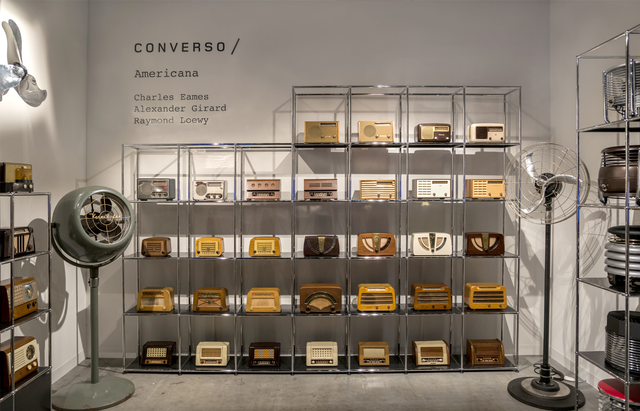AMERICANA / Industrial Design of the 1940’s
Design Miami Best In Show: Best Curio Display: Americana: Industrial Design of the 1940s by Converso, Chicago in collaboration with USM Haller
CONVERSO has found the perfect partner for the presentation of this collection in USM Haller, whose modular system of storage and shelving has found its way into many major museums for the display of objects and collections.
One hundred years before the Digital, a world of Apps and Devices, Electrification was the Revolution and the United States was America, a mythic Industrial powerhouse churning out invention and transforming the day to day with the outrageous, astounding electrical devices that would make us Modern.
Before Jobs and Gates, there was the genius of Edison, Westinghouse, and Tesla and the App stores of the 1930’s were filled with the products of General Electric, Zenith, Hallicrafter, Detrola, Crosley, Tele-Tone and all the others. A short decade after the earliest broadcasts, the first iPhones were mass produced Radios: Paul Frankl could report a Zenith set broadcasting world news on an early trip to the interior of China.

At the heart of the collection is an in depth exploration of the pioneering molded plywood work of the Eames for the major radio manufacturers Zenith, Emerson, Tele-Tone, and Hoffman, when war time rationing of plastics necessitated the new material technology of plywood and opened a brief two year window that resulted in the creation of hundreds of thousands of molded plywood radio casings. While standard design histories have focused on this episode as a bridge to the Eames’ classic work for Herman Miller, contemporary art historians like Talia Shabtay are tracking the Eames’ wider interest in radio technology as foundational to their later work with IBM and their interest in the science of computing.
The collection is a treasure trove and illustrates the strangeness of the arrival of the modern: harmonicas, clocks, toasters, staplers, ray guns, fans, irons, radios, hair dryers, bottle openers, record players. Many objects are already known from major museum collections. Some were special presentations at World Fairs. Many are presented here for the first time, in depth. All, even with our perspective of time, remain as convincing as the day they were removed from the box…and plugged in.

